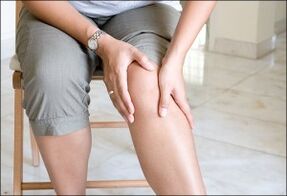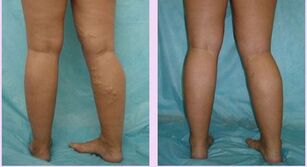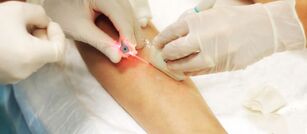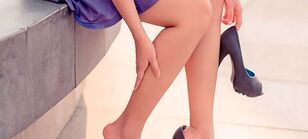
The small protruding veins are not intimidating yet, but they should make you think!
The early stages of the disease are characterized by mild symptoms. However, a woman who cares about her health should not overlook the first signs of varicose veins:
- heaviness in the legs until the end of the day.
- swelling of the feet?
- the appearance of pigmentation on the skin of the lower legs and thinning of the skin.
- numbness of the limbs, frequent muscle cramps in the legs
- protrusion of the veins above the surface of the skin.
- the appearance of a pattern of veins, spiders on the legs.
If, returning home after a working day, a woman finds her feet in a "sad state", then we should not blame only the uncomfortable shoes or an extra "piece of salt" at dinner. Swelling and heaviness in the legs are the first sign of developing stagnant blood vessels. Remember - venous diseases are difficult to treat. Early prevention and early medical care can stop or significantly slow down the process of venous dilatation. Treatment should begin as early as possible.
Grade 1 colitis
The main causes of varicose veins are considered to be pregnancy, overweight, prolonged physical activity, sedentary lifestyle, and genetic predisposition to such a disease. Ordinary people called varicose veins "the disease of flight attendants" because of the peculiarities of this profession and the long standing on their feet. This degree of the disease is the mildest.

Classify the disease according to different factors. One of the classifications is according to the stages of development of the disease:
- Grade 1 varicose veins or compensatory stage. Grade 2 grade veins or stage of subcompensation.
- Grade 3 Depths or decompression stage.
Different stages of varicose veins of the lower extremities have radically different treatment. You should not try to deal with the disease yourself. This can only hurt and lead to catastrophic consequences. It is best to seek the help of a qualified professional.
The first degree of varicose veins is characterized by swelling at night, nocturnal convulsions. Often, people mistake all these symptoms for ordinary fatigue. However, already at this stage it is necessary to take precautionary measures, such as warming up the feet to improve overall blood flow, light foot massage, regular swimming, cycling.
Varicose veins of the first stage can also manifest as cramps in the calf area, patients often complain of a feeling of stretching of the legs or burning in the muscles. This is increasingly accompanied by pain in the lower extremities.Already at this stage, manifestations of the visual nature of varicose veins may be observed, which should immediately warn:
- Slight cyanosis of the skin.
- The first cobwebs appear in various parts of the body, most often in the legs.
- Visible fibrillation of the veins.

Another important factor in the manifestation of the first stage of varicose veins is the external conditions in which a person is. For example, in a hot environment, symptoms increase, swelling, pain and convulsions increase.
Treatment of first degree varicose veins
Sometimes doctors recommend using extra bentonites, which are quite effective in treating first stage varicose veins. Separately, it should be said about massage: not every such type of treatment is suitable for this disease. If after the procedures the pain only intensifies, then it is necessary to change the approach to choosing a massage complex.
It is more often worthwhile to arrange relaxing cool foot baths, which will soothe the muscles, relieve swelling, help reduce pain and relieve fatigue. However, hot baths should be excluded, as they do not improve the condition of the limbs with varicose veins.
Doctors may recommend the following treatments for this degree of varicose veins:
- Sclerotherapy - a special medicine is injected directly into a vein with a needle. The action of the drug aims at the absorption of the veins, at the strengthening of the weak walls of the blood vessels, at the obstruction of the blood flow in the desired area.
- Ozone therapy - an action aimed at strengthening blood vessels, absorbing varicose veins.
Each of the above options is quite effective. However, the maximum result can be achieved only if all the recommendations to be followed after using the procedures.
The use of special compression garments is paramount. Such an element helps to create pressure in the veins, thus preventing them from expanding further.
Causes of the disease
There are more than fifty reasons that can cause a change in the venous system. Particularly vulnerable to the disease are people whose profession is associated with stress on their feet and a sedentary activity: salespeople, hairdressers, programmers, accountants, drivers.
Scientists have conducted many years of research and identified the main causes of varicose veins:
- Hormonal changes in the body: pregnancy, menopause, transition age.
- Obesity of any degree?
- Genetic predisposition. 70% of children whose parents suffered from venous insufficiency develop varicose veins.
- Weak muscular system?
- Wear uncomfortable underwear: socks with tight elastic bands, tight pants for men.
- Lack of activity and physical activity
- The habit of sitting with one foot on top of the other.
- Rare body position change: long posture, lying, sitting
Chronic diseases: diabetes mellitus, high blood viscosity.
Of the ten patients with varicose veins, eight are female patients. The weaker sex is subject to venous pathologies due to forced hormonal disorders during pregnancy, after childbirth, during menopause. The second important factor for which women suffer from leg pain more often than men is the love for high heels.
Rules and instructions
In the early stages of varicose veins, the patient is advised to follow the rules:
- Hiking once or twice a day. You need to walk at a slow pace, stopping periodically to rest.
- Wear comfortable shoes with heels no larger than 3 cm. The upper of the shoes should not have a pull device, the laces are not tied as tightly as possible.
- Watch workouts in the gym twice a week. Loads are selected separately by doctor and trainer.
Review your diet. Foods do not include foods high in sugar, fatty meats, flour products and starchy vegetables. Most of the diet of a patient with varicose veins consists of steamed or boiled vegetables. Fried and spicy foods are not recommended.
- The feet should rest at night. Bleeding will increase if you lift your legs and throw them on a high pillow or on the back of a sofa.
- If the work involves little movement, it is recommended to lubricate the feet with refreshing gels or ointments containing heparin.
- Special compression garments or elastic bandages are used daily. Special underwear are selected by a doctor. The peculiarity of compression garments is in the compression function. Pressure on the body occurs with varying force, which forces the blood to circulate violently.
- You change position frequently. If you have to sit at work all the time, then get up and sit down several times every 30 minutes. Exercise will help prevent leg varicose veins and hemorrhoids.
Treatment of different stages
A treatment that is effective in the early stages can have the opposite effect on advanced pathology. The choice of treatment methods should be appropriate for the stages of varicose veins:
Compression jersey
It is used in all stages of varicose veins, however, the degree of compression should vary significantly at different stages of the disease. In the early stages of varicose veins, compression is used for prophylactic purposes during posture and sedentary work.
Compression can stop the development of varicose veins, but before medical use it is necessary to consult a venologist, as compression is dangerous, exacerbating the problem of venous outflow. In the stages of compensation and subtraction for swelling and visible varicose veins, underwear of the first and second class of compression is usually prescribed.
The third compression category is used in cases of severe venous insufficiency. If lymphedema occurs, use fourth-class underwear. The hospital jersey is worn for treatment.
Folk remedies
Traditional medicine helps treat varicose veins in the early stages. The following tools are widely used:
- application of cabbage leaves
- potato, wormwood and garlic compresses.
- chestnut tincture,
- hops and nettle decoction.
However, the ease of use, accessibility, softness of the action of folk remedies are combined with their low effectiveness (compared to drugs), so the enthusiasm for these methods is full of disease progression. Herbal remedies and compresses should be applied after medical advice and used only as an adjunct to the main treatment.
Hirotherapy
Leech treatment is indicated in rare cases of advanced varicose veins. Leeches are sometimes prescribed for thrombophlebitis. Leeches can cause allergies and food ulcers that make varicose veins worse. Currently, the method is being replaced by non-traumatic drugs containing anticoagulants.Medicines
Medication can help relieve symptoms. Tablets, capsules based on grape extract, chestnut, which are biologically active additives, are effective in the early stages of varicose veins.Aid is prescribed at the compensation stage. Most ointments and gels contain heparin, which prevents blood from clotting. To a large extent, the effect of ointments and gels is caused by massage during application.
But at the stage of compensation, the application of such products can cause additional manifestations on the skin. Medication relief is often temporary and does not cure the underlying cause.
Functions

Laser coagulation and sclerotherapy are minimally invasive techniques for blocking veins from circulating blood. Used for small diameters of dilated veins in the early stages of varicose veins (when getting rid of spider veins, nets)
Intranasal laser coagulation of varicose veins
Phlebectomy
Surgical removal of veins is indicated in the third stage of the disease, accompanied by food ulcers and complications. In some cases, varicose veins in the legs do not develop according to the model presented in the gradual classification. For example, the symptoms of the first stage may be completely absent: an image of overcompensation appears immediately.
Ή, as the disease progresses, some signs of varicose veins are not added to the symptoms of the previous stage, but disappear. Therefore, at the beginning of the 21st century, Russian phlebologists, in addition to the gradual approach, adopted the international classification (CEAP), which, when diagnosing the severity of the disease, takes into account the facts of the individual characteristics of the course of varicose veins. and the effects of treatment.
Symptoms
Symptoms of pathology with the onset of varicose veins do not make people think of venous disease:
- feeling of heaviness in the legs.
- fatigue after walking.
They tend to be associated with flat feet, unusually high heels, new uncomfortable shoes, lumbar osteochondrosis.
Only the visual detection of cyanotic dilated veins under the skin raises the suspicion of varicose veins.

The vascular plexus as the first sign of varicose veins appears more often below the knees
Women go to the doctor when they notice unpleasant cosmetic defects in the form of reddish venous "spiders" on the legs, below the knees, on the skin of the thighs.
The "influx" of young women seeking treatment from a venologist who specializes in venous diseases is usually associated with the upcoming summer season on the beach, taking care of their appearance despite their health. With the help of pills, they want to restore the beauty of the skin of the feet.
Pregnant women pay more attention to their condition. In addition to aesthetic changes, they have difficulty walking, increased fatigue at night.
The initial stage of the disease is indicated by the disappearance of clinical symptoms after lying down.
You can verify this experiment by yourself: measure the volume of the lower leg at the level of the ankles or calf muscles in the morning and evening after work. If the difference is greater than 1 cm, there are signs of initial varicose veins.
The following are displayed:
- leg pain?
- swelling of the feet?
- feeling of fullness and heaviness in the legs.
- muscle cramps at night?
- dilated veins become like dense snake bands with dark areas of skin
These signs are undoubtedly manifestations of venous insufficiency and require treatment.
The main causes of varicose veins in women
Fatigue and edema may be the first manifestations of venous blood flow disorder

The sex hormone estrogen plays a special role in the development of varicose veins in women. Its action leads to problems such as weight gain, depression, edema, drowsiness, dry mucous membranes. This hormone increases the permeability of small blood vessels. The fluid easily leaves the bloodstream, the blood flows less. Excess fluid accumulates in the surrounding tissues. These factors contribute to the development of stagnation in the vessels of the lower extremities.
Reasons for an increase in estrogen in women:
- An imbalance in estrogen-progesterone production. It occurs as a result of a decrease in the level of progesterone in a woman's body.
- Chronic stress. During stress, cortisol is produced in the body and in turn inhibits the synthesis of progesterone.
- Pregnancy. During pregnancy, the amount of estrogen in a woman's body increases.
- Taking contraception. Varicose veins appear as a side effect of taking these medications.
- Liver disease, because estrogen is removed from the body by the liver. With its poor functioning, this hormone accumulates in the body.
- Age-related changes in hormone levels also lead to an imbalance of sex hormones with the predominance of estrogen.
The full function of the liver is important for maintaining normal hormone levels. In addition to removing excess hormones, it participates in the synthesis of substances - progesterone precursors and estrogen. To improve his work, physical activity, good nutrition and minimization of the intake of toxic substances in the body are required.
Treatment of varicose veins with traditional medicine
Treatment of varicose veins with drugs is the most effective way, which is suitable for almost all patients. A wide range of drugs allows you to choose a more suitable drug for long-term treatment.
Pharmaceutical methods of treating varicose veins of the legs
Venotonics are one of the most effective drugs in the treatment of this disease. Venetian drugs are drugs that help increase the tone of the veins and better blood flow from the veins.These tablets can prevent the formation of characteristic varicose veins and nodules.
Applying ointments
The best treatment for varicose veins is a holistic approach, which includes medicines in the form of tablets, as well as the use of gels and ointments for external treatment of problem areas.
Ointment for varicose veins in the legs also helps to improve blood flow and prevent the formation of blood clots.
These funds are recommended for use only after consulting a doctor, who will also determine the duration of treatment and the regimen of use.Do not self-medicate - this may further damage the patient's already poor condition.
Consequences of varicose veins.
Varicose veins can lead to the development of food ulcers in the legs, thrombosis in the varicose system, thrombophlebitis, pulmonary embolism (instant death) in the midst of apparent complete health.The complicated stages of varicose veins require surgery. Although women often suffer from varicose veins, men are also affected by this disease, mainly for hereditary reasons.
A man under the age of 40 can appear on the operating table and radical measures are used to cure him of varicose veins - diseases are removed.
Varicose veins are easy to remove. In the groin, the surgeon makes an incision, where the large saphenous vein affected by varicose veins flows into the femoral vein. The vein is exposed, ligated and cut and a second incision is made in the ankle. With the help of a special metal catheter, which is inserted into the lumen of the vessel, the entire dilated vein is removed.In the future, with the right operating technology, no recurrences are observed. The blood supply to the leg is distributed to other vessels and after 2 weeks everything is fully restored.
Risk factors that predispose to the development of varicose veins.
- Genetics and connective tissue pathology?
- Woman?
- Taking hormonal drugs: progesterone, estrogen?
- Pregnancy?
- Age: most common after 50?
- Overweight and physical inactivity.
- Prolonged standing (standing work: hairdressers, salesmen, teachers, etc. ).
- Obesity.
Symptoms and signs of varicose veins and chronic venous insufficiency.
| Symptoms of varicose veins | External signs |
| Pain pain | Telangiectasia |
| Heavy legs | Wrinkle veins |
| Fatigue | Varicose veins |
| Puffiness | Thrombophlebitis |
| Itchy skin | Overpainting |
| Foot discomfort | Bleeding from a wound node |
| Calf muscle cramps | Ελκος |
Varicose veins treatment options.
The choice of treatment depends on the diameter and type of varicose veins
- Varicose veins of clear veins
- Drug treatment
- Elastic compression and bandaging of the feet
- Sclerotherapy by injection
- Foam sclerotherapy
- Laser treatment
- Miniflectomy
Dear women, varicose veins can wrap you in a long skirt and pants forever. If pills and ointments are not able to return your feet to normal, then it remains the only sure way to remove dilated veins. How and where, it is only after consultation with a specialist venologist. Veins can now be operated on without hospitalization, without anesthesia, without incisions, with high precision. You just have to take a step towards your health.
Detailed information on varicose veins, symptoms, disease prevention, special exercises, treatment methods and the necessary diet can be found at: ovaricoze. ru
How varicose veins manifest in the early stages. Because it is dangerous
As a rule, mucosal varicose veins are painless. Therefore, the most common complaints that patients turn to doctors are cosmetic defects - visible reticular veins.
In rarer cases, the appearance of such a varicose vein is accompanied by a burning sensation or other changes in skin sensitivity.
In addition to these symptoms, the first stage of varicose veins is manifested:
- gravity on the legs
- increased leg fatigue
- cramps in the muscles of the lower extremities, especially at night.
- itching at the site of vascular network.
- swelling of the feet and legs.
In order to prevent the progression of the disease, it is necessary to start treatment in time
Therefore, it is important to consult a venologist, angiologist or vascular surgeon in time, who will tell you what to do with such skin formations. First, a specialist will perform an examination and prescribe the necessary additional tests to help identify the causes of asterisks or eyes, as well as to determine the degree of venous circulation impairment.To determine the degree of vascularfaults and their inadequacy, do:
- whole blood count (indicates if the patient has anemia or thrombocytopenia).
- biochemical blood test (detects blood clotting disorders or liver and kidney function).
- general urination (detects kidney problems)
- vascular ultrasound - double angiography (reveals vascular wall pathology and blood flow disorders).
- Contrast X-ray venography (determines the location of venous lesions and the degree of impairment of their functions).
If you do nothing after detecting the first signs of varicose veins, it is possible:
- Inflammation joins and thrombophlebitis develops in the superficial veins of the lower extremities.
- transition of the pathological process from superficial veins of the lower extremities to deep.
- venous thrombosis. If thrombosis occurs in the venous vessels of the head, it is dangerous for strokes and sinus thrombosis. Pulmonary artery thromboembolism is a fatal complication that occurs due to the separation of a blood clot from the vessel wall and obstruction of the pulmonary artery lumen.
If you ignore the appearance of the original varicose veins and do not start treatment on time, the disease will progress. Then the development of complications will become inevitable.
Prevention
Do not forget the precautions. For prevention, you need to devote time to sports.
Avoid excessive physical activity. Wear comfortable shoes with low heels (up to 4 cm). Remember that hot baths, baths and saunas negatively affect the health of the feet.
And following these simple guidelines will help prevent the development of this disease:
- try to get rid of bad habits - alcohol and smoking negatively affect the condition of your blood vessels.
- compression therapy - wear medical socks, tights and knees.
- diet, weight control (overweight people are more likely to suffer from varicose veins), exclude fatty meats and poultry, skip spicy and salty foods, be sure to include vegetables and fruits in your diet.
- massage - get used to light foot massage after a long day, this will help you relax and improve the body's natural blood circulation.
Any disease is always easier to prevent than to cure. Be healthy!














































